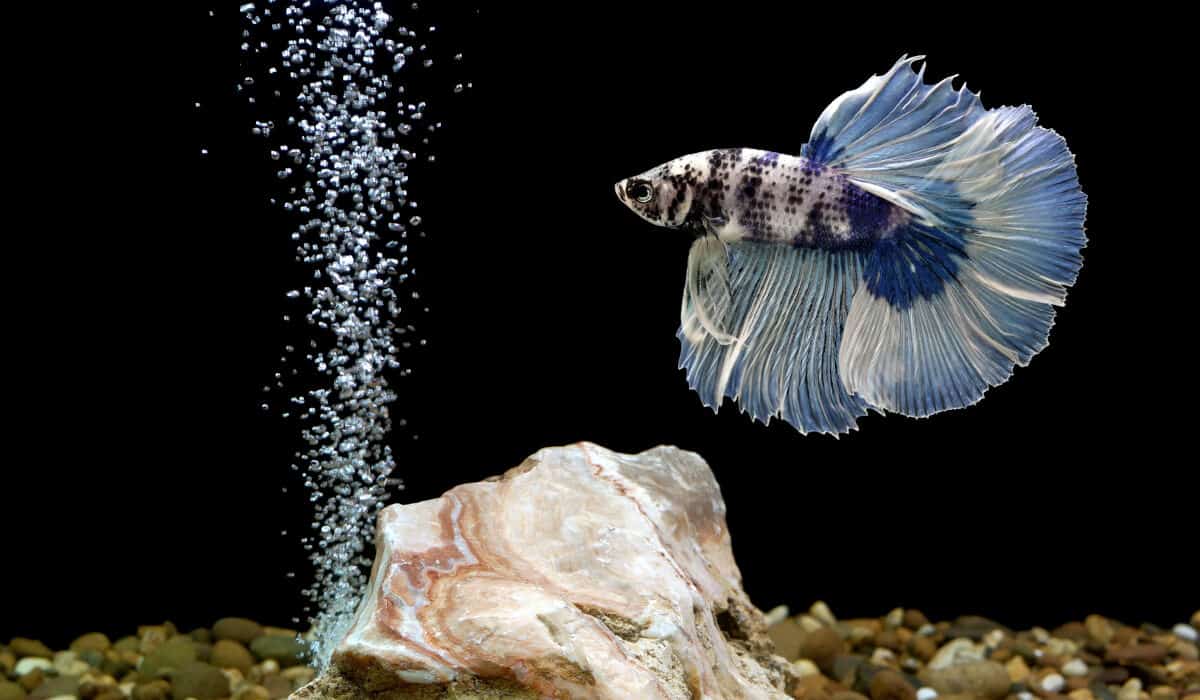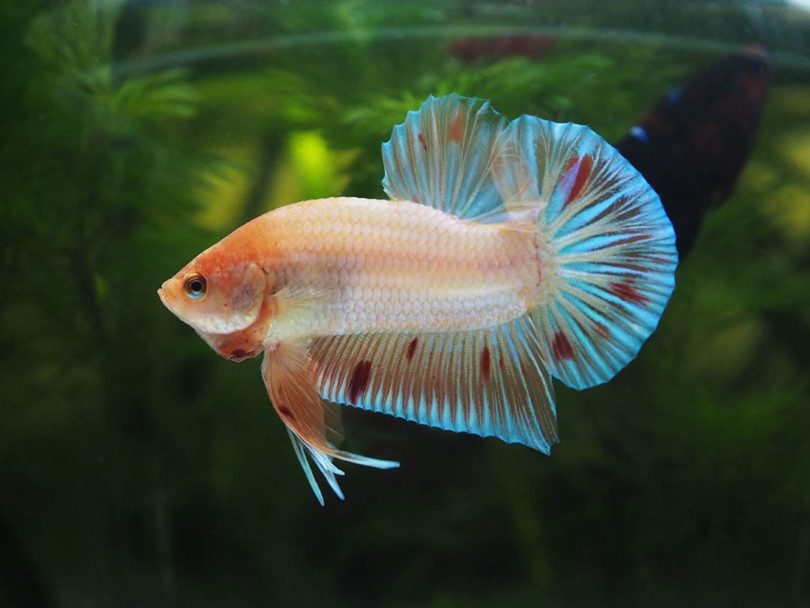How to Breed Betta Fish: Vet-Approved A to Z Guide (with Pictures)

Updated on
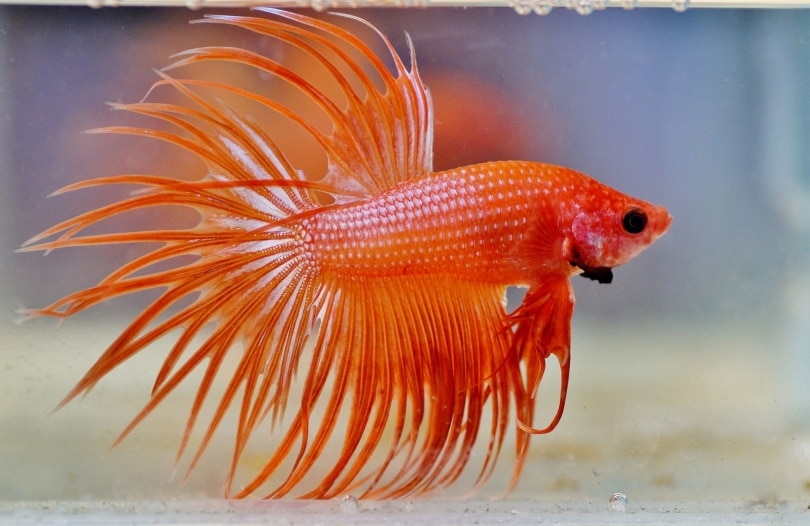
Looking for detailed information on how to breed betta fish? It’s a complicated process but it’s also incredibly rewarding if you do it right.
Breeding betta is not easy, it’s not at all cheap and it requires knowledge, time and dedication on your part to do it properly. We can help with the knowledge, but you have to bring everything else to the table.
In this guide you’ll find all the information you need to learn to successfully breed betta.
We’ve detailed everything from choosing your male and female to mate, how to introduce them to each other, setting up a spawning tank, taking care of the fry, and all the pitfalls – with solutions – that you might encounter along the way.
We’ll start with choosing the right fish to mate.
A single spawning pair of Bettas can produce over 200 eggs on average. Raising Betta fry isn’t a decision you should take lightly on a whim. It requires a great deal of time, money, space, and extra tanks and is also often associated with heartache in the form of many fry that do not make it to maturity. It is best to leave breeding Bettas to professionals unless you are absolutely certain that you can care for all the fish, grow live cultures, and have the resources required to undertake a spawning.
Telling Male and Female Betta Fish Apart
The reputable breeder or pet store where you get your breeding pair will be able to tell you what sex your fish are but you need to learn how to distinguish this for yourself so you can deal with later generations of fish appropriately.
Male betta fish have longer fins and brighter, more vibrant coloring which make them more common pets.
Female betta fish tend to be smaller with shorter fins, muted coloring and white spots which look similar to grains of salt embedded under the skin.
Choosing a Breeding Pair
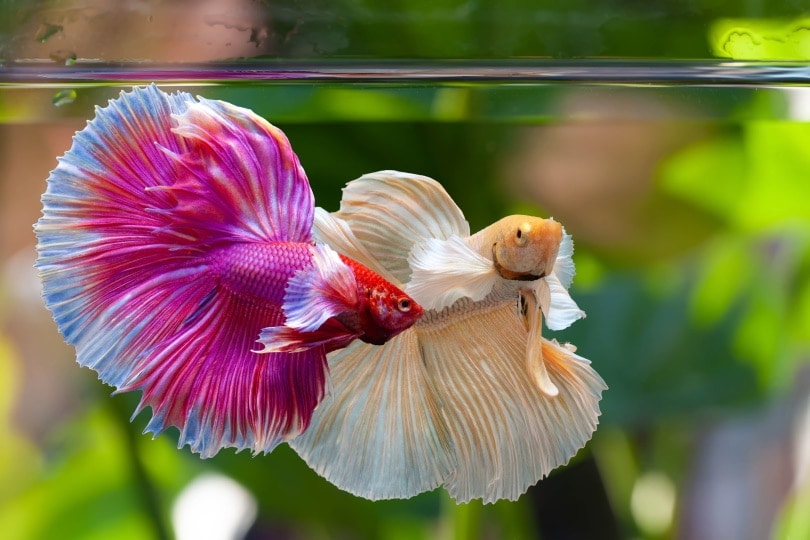
Deciding to breed two random betta fish often leads to mutt babies with unattractive coloring. A good pair of bettas for breeding will be around 6-8 months old and have similar fin types to each other.
Most betta fish have either red or blue as the dominant color. You’ll also want to pay attention to the dominant fin type, which is usually veil (unfortunately the less attractive of the two fin types).
The breeding process for betta fish is somewhat stressful from a biological point of view, so it’s also important to choose fish that have been living in excellent conditions and are in great health.
The female betta should be either almost or exactly the same size as the male.
Getting a larger female betta greatly decreases your chances of successfully breeding the pair.
It’s often best to get your breeding pair from another breeder so you can find out the details about their genetic background, including their dominant color and fin type.
When you purchase betta fish from a pet store it’s extremely difficult to verify anything specific about their family history, making it difficult to pair the right fish together.
A good breeder will also be willing to give you some extra advice if you run into any difficulties along the way.
Getting the Right Equipment
Buying all the right breeding equipment is just as important as finding the right pair.
Bettas only breed in a very specific type of environment and must be kept in separate tanks when not actively breeding.
Spawn Tank Essentials
- The Tank – A betta spawning tank should hold 5-20 gallons of water. You can have betta spawn in a smaller fish tank or bowl but it’s not as likely to be successful.
- Plants – Live non-rooted plants (you don’t want to have any substrate in the tank, which is essential for almost all rooted aquarium plants) will help your female feel secure and give her places to escape the male for a while. Organisms which grow on the live plants will later become a source of food for the fry. Some of the best plants for a spawning tank are java moss, java fern, and foxtail.
- Caves and/or decorations – The betta breeding process is sometimes violent and either the male and the female (or both) may get injured. Both need to have hiding places to relax and recover.
- Heater – Betta fish always require a heated environment but this environment should be a little warmer than normal to encourage breeding, ideally 82.4°F (28°C).
- Anchor – This helps hold down the male’s bubble nest and can be anything from a half cut styrofoam cup to a square of bubble wrap to a fancy anchor bought from an aquarium store specifically for this purpose.
- Sponge Filter – A sponge filter reduces how frequently you have to change the water in the tank, reducing the stress on your bettas and encouraging them to breed. This isn’t absolutely essential but it makes a significant difference.
- Chimney – Chimneys give a safe way for a breeding pair to view each other and can also help you identify when a female is ready to breed. You can create your own using the sterilized top of an old soda bottle or buy one from an aquarium store.
- Indian Almond Leaves (optional) – Almond leaves will turn the aquarium water a darker color and give it a stickier texture, making it easier for your betta to build a nest. Please note that if you choose to use these, they should be clean, dry leaves. They also lower the water’s pH a bit by releasing tannins – which also give your aquarium a tea-like appearance. Generally, Bettas can tolerate a wide range of pH ranges comfortably provided you consistently keep the pH within reasonable ranges.
- Methylene Blue (or other medication) – a good broad spectrum medication should be at hand in the unfortunate event where one of your breeding bettas gets injured. The antifungal properties of Methylene Blue can help expedite healing and recovery.
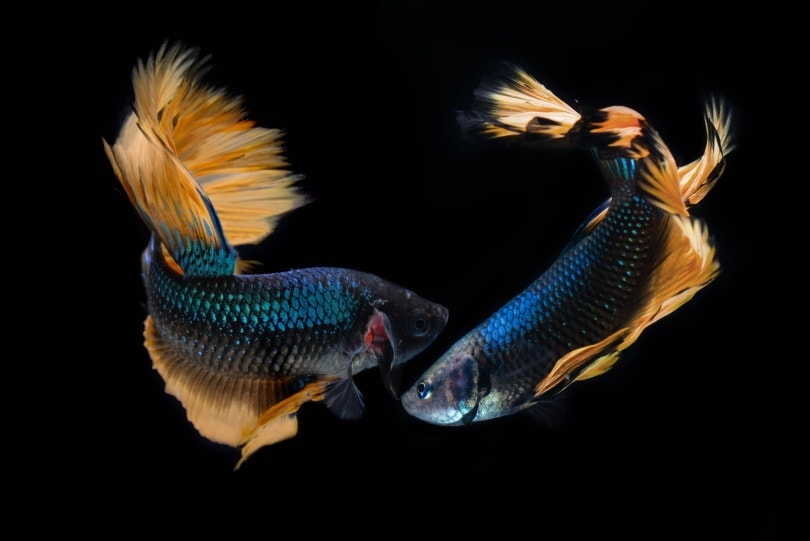
Growout Tank and Fry Needs
Once your betta have spawned you’re going to need a whole new set up to help them thrive.
If you did the initial spawning in a large enough tank (at least 10 gallons and up to 20 depending on the size of the spawn) you can use the original tank and most of what you’ve set up. But you will also want to buy several large glass jars or small fish bowls which you can use to separate the fry as they mature (which happens quickly!).
If you want to use your spawning tank to spawn more fry while some are still growing you will need to set up a second betta tank with all of the same equipment. However, please note that you shouldn’t use the same female for multiple breedings in quick succession, it is advised to give the female at least 4 weeks of rest after a spawning session.
Making Your Breeding Pair Comfortable
Your breeding pair should be kept in the best conditions possible. This means both of them should have a tank with at least 5 gallons of water, a high-quality heater and an aquarium lamp that maintains their day/night cycle.
A few weeks before you start breeding, start feeding them live food. Live or dried brine shrimp, tubifex worms, roaches, and specialist pellets all make for the best recommended betta foods.
This “conditioning” process takes anywhere from a week to up to 3-4 weeks, depending on the health status of your fish. The fish’s nutrition plays a key role in determining how many eggs a female can produce. Poorly conditioned females may produce just around 15 eggs, whereas healthy, well conditioned females can sometimes produce up to 500 eggs!
- Their age
- Inbreeding (reduces chances of success)
- Their strain (may increase or decrease chances of success)
- How recently they were bred (females should be rested at least 4 weeks between spawnings).
- Their health status
- Their nutrition
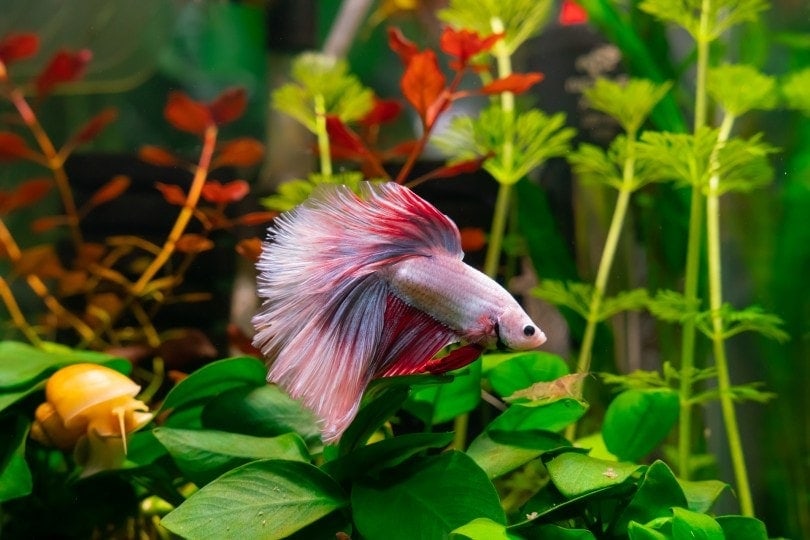
Setting up the Spawning Tank
Once you’ve acquired all the right equipment setting up the spawning tank is fairly simple.
You want to make sure the nesting media is on the opposite side of the breeding tank from any filter outlets. Caves and other decorations which provide hiding spots for females should be kept away from the nesting media as well. This includes all plants and Indian Almond Leaves.
During the spawning process, the tank water should be 5-10 cm deep. This is about the same water level as the rice paddies of Thailand where bettas naturally mate. The temperature should be 82.4°F (28°C). Not only is this temperature ideal for Bettas, but it also offers the best environment for bubble nest construction and stability.
Understanding the Process of How to Breed Betta Fish
Before you start breeding your betta you should take the time to learn as much about them as possible, including their specific roles during different parts of the breeding process.
The Male’s Role in the Breeding Process
The male’s main job is to create a bubble nest which will actually be comfortable for a female to spawn in.
Once he’s created a nest he will lure the female in for the spawning process, during which he squeezes the eggs out of her.
After this embrace , he male will chase the female out of the nest and herd all the eggs back to the nest, where he will tend to them until they hatch.
Newly hatched fish (also known as fry) usually can’t orient themselves well enough in water and often fall to the floor of an aquarium. The male’s task at this point is to pick them up and place them back into the bubble nest. Once the fry are able to orient themselves properly, they often swim away from the nest. At this point, the male should be removed from the aquarium. Leaving him in for longer periods of time runs the risk of him eventually misidentifying his fry as “foreign” fish and eating them.
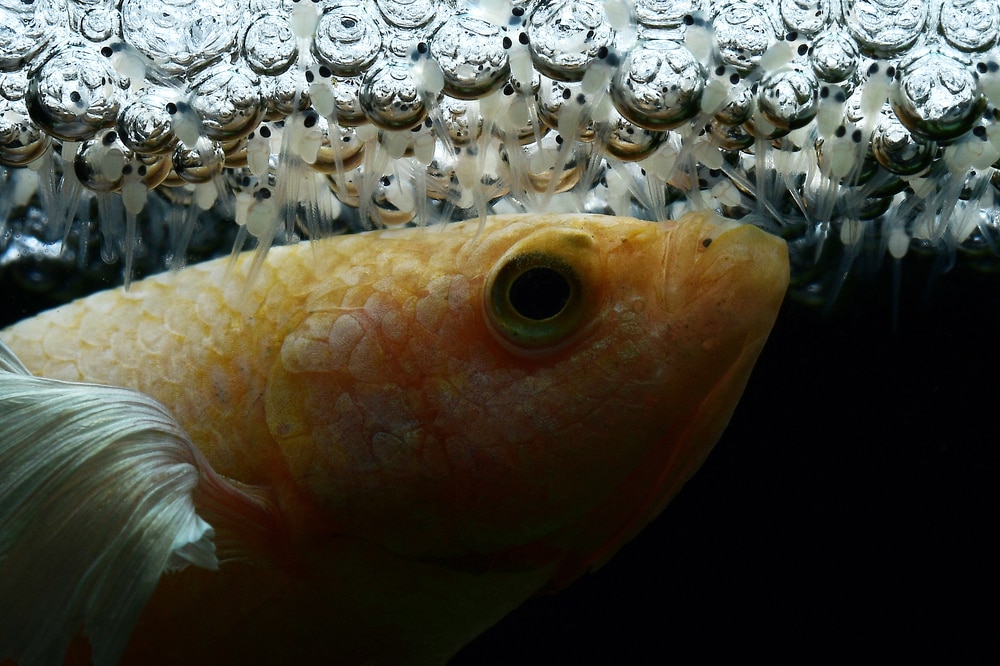
The Female’s Role in the Breeding Process
Female bettas aren’t actually an active part of most of the process.
Their main job is to attract the male’s attention so he actually builds a nest. After the spawning they will hide in the caves or other decorations to recover. The female should be removed from the aquarium after the pair have spawned, they have no maternal instinct and the male may not recognize her as a “mate” after they’ve spawned and may attack her in an effort to defend his nest.
Introducing the Breeding Pair
Males don’t like sharing their territory with other fish, even female bettas, which often makes introducing the breeding pair the hardest part of the process.
You want to start by placing their tanks beside each other so they can see each other without being able to attack. You can also put them in the same breeding tank with a divider. Either way, they need 3-7 days to get used to each other before you put them together.
The more aggressive your male betta is, the more time they should have to become familiar with each other.
Eventually the male betta should start flaring and may even begin building a nest or attempting to chase the female, signaling that he is ready to breed.
When the female is ready to breed you’ll notice vertical stripes appear on her body as well as a small white egg tube sticking out from the ventral fin.
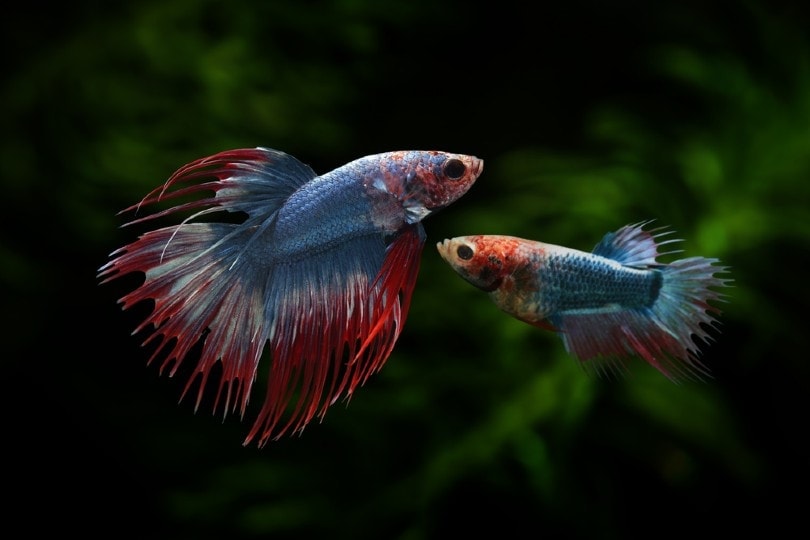
Getting Them Used to the Spawning Tank
Once the breeding pair has seen each other it’s time to let them see the spawning tank.
You should put the female betta fish in the tank first for 2-3 days, enough time to find all the best hiding spots and become comfortable with the environment.
After 3 days remove the female and place the male in the spawning tank, where he will stay until the actual spawning process begins.
Letting both betta figure out their surroundings before you attempt to breed them makes them more likely to breed rather than becoming aggressive.
Doing the Chimney Test
This is a final test to make sure your bettas are actually going to breed with each other instead of trying to fight with each other.
After you’ve let both betta fish get used to the spawning tank and while the male is still living in the spawning tank, use a “chimney” (the top of an old soda bottle is perfect) to lower the female betta into the water. This gives them one more chance to get to know each other before they actually make contact.
If the fish are very aggressive towards each other at first, leave them together with the female in the chimney for 3-4 hours to see if they calm down. You can also return the female to her normal tank and try again in a couple of days.
Bettas are known to have some degree of nipping and biting when introduced to each other. However, if either individual seems overly aggressive, the pair should be separated. Some fish may instinctively be very aggressive during mating, no matter how much time they spend separated with a divider in between their tanks. These individuals might not be the best for mating purposes. Injured fish can be nursed back to health using Methylene Blue at 3 ppm (or 0.0003%) daily (follow instructions on the product you purchase for a better understanding of how to dilute and dose it.
Putting Them in the Same Tank
Once your bettas have been introduced and your male has built a bubble nest it’s time to put the female in the spawning tank properly so they can interact. The best time to introduce them in a tank is around 1 hour before their “daylight” light is switched on.
At first the male will chase the female around and nip at her, so it’s important to supervise this part of the process and make sure it doesn’t get out of hand.
Unfortunately, there’s no way to be 100% sure when your male is actually just being aggressive, so it’s entirely up to your discretion.
At this point, the female may destroy the nest.
If this happens you should remove her and try to reintroduce them a few days later. If it happens again you will need to find a new breeding pair.
The Spawning Process
Eventually your male will lead the female betta back to the bubble nest, where he will attempt to release the eggs from the female’s body by wrapping the female in a tight embrace.
When the eggs are successfully extracted from the female, the male fertilizes them (externally) and the male will attempt to collect them all in his nest.
At this point the female will generally be in a trance-like state, floating in the tank as if she is dead. This state is generally very brief, giving the male just enough time to get all the eggs into the bubble nest.
When to Remove the Female
Female betta fish don’t help care for their eggs and may actually eat the eggs, making it important for you to remove the female immediately after spawning. The spawning process typically takes around 1 to 4 hours after the first eggs are released.
Remember to scoop her out gently to avoid injury or unnecessary stress. The female will already be somewhat injured from the mating process.
When to Remove the Male
Betta fish eggs typically hatch 24 to 48 hours after the breeding pair spawn. Once the eggs hatch, it is very important to not remove the male immediately. At this point, the male plays a very important role by picking up the fry and placing them back into the bubble nest. This is important because until the fry learn to orient themselves properly in the water, they cannot come up to the surface to breathe and therefore, require the male to assist them by placing them back inside the bubble nest. The male will also repair and reconstruct the nest as needed during this period. The male is needed for this purpose for about a day.
During this time the male fans them with his fins so the air around them circulates, and will likely react aggressively to any intrusion (including your hand!) It’s important for a spawning tank to not have a strong filtration as it may pull the fry in. Leaving the filter intake off for a few days for this purpose is acceptable. To ensure your fish’s safety, you should check the ammonia levels in the tank on a daily basis. This is also why it’s advised to use live plants, as they help remove ammonia from the water.
The male may also choose to move the eggs away from the nest or to move them to different areas of the nest.

Caring for Fry
After you remove the male betta it becomes your responsibility to take care of the fry.
This is an incredibly involved process which will determine how much of your spawn actually survives, so learn everything you can and prepare to keep a very watchful eye on these little ones.
Feeding Betta Fry
For another 2-3 days, they will be floating near the top of the tank, still feeding off of their egg sacs. You will want to start feeding them on day 5 after the spawning (for example: if your pair spawned on a Monday, you would want to begin feeding them on a Friday). It is advised to separate the fry into tanks that hold roughly the same number of fry (around 30 fry in a tank that holds around 1 liter of water (0.3 gallons) and is about 5 cm deep is advised.
Betta fry are incredibly tiny and therefore require much smaller food than your adult bettas, and they also only eat live food.

Your best option is rotifers or infusoria, which you can purchase from a pet store. If you are committed to breeding bettas you will want to create a setup which allows you to grow your own cultures so you have a constant food source
Once the fry are about two weeks old you should start feeding them a diet of mostly baby brine shrimp 2-4 times a day.
After the four week mark, you should separate the fry into their individual tanks and continue feeding them baby brine shrimp for about another month.
Once they are about 2 months old you can introduce your fry to dry food, although it is still better to feed them frozen or live food. Some bettas will outright refuse dry food.
Changing the Water
Two weeks after the fry are born they’re ready for their first water change. Unfortunately, they are also still so small you can’t use a siphon without sucking most of them up.
There are special systems for doing just this but they’re quite expensive and you probably already have access to a simple but equally effective solution: secure a chopstick to one end of an air tube and use this the same way you would use a regular siphon.
At first you only want to remove 1 liter at a time. Put the old water in a jar and set it down in a lit area so you can check to make sure you didn’t accidentally suck up any fry.
New water should be added by connecting the airline tubing to a set of air stones. Place 2L in a jug or bucket above the tank and connect the tubing to it. The air stones will ensure that the tubing delivers a trickle instead of a stream. This prevents it from disturbing the fry, who are extremely sensitive to even the smallest vibration.
After you’ve done the first water change you’ll have to change the water again every day. You should be removing 1L and replacing it with 2L until the tank has filled up to its maximum capacity to make it more suitable for the growing fry.
Once it’s reached this point then you want to continue taking 1L but only replace it with 1L so you can maintain a good water level as well as good water quality.
Moving the Fry Out
When the fry are about a month old you’ll want to move them into a larger tank to finish their growth. You may want to get multiple growing out tanks for bettas of different sizes.
If you want to keep track of which fish are from each spawn you will want to keep each group of fry in a separate tank for growing out, even if this means the tanks are smaller. But you never want to have a spawn in anything less than a 10 gallon aquarium.
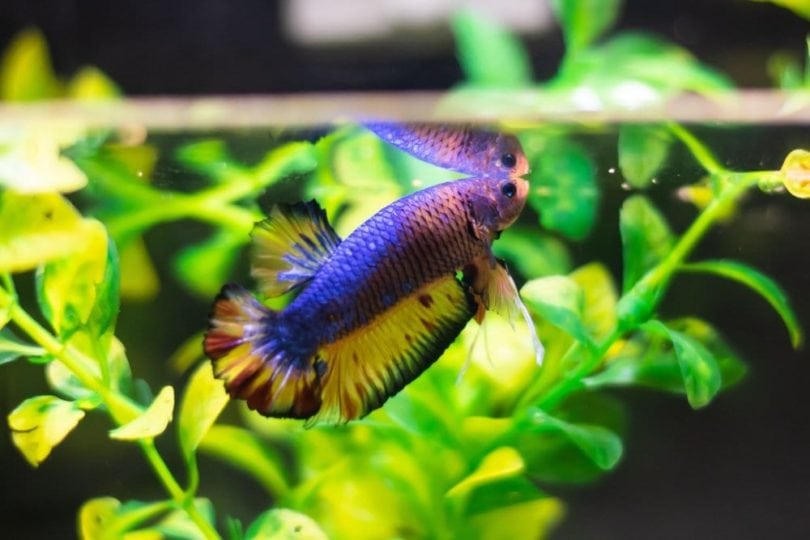
Dealing With Aggression
At around 8-9 weeks old the fry will start to mature, showing their first hints of color and gaining their personalities.
This is when they start to get aggressive, so it’s essential that you are constantly watching them during this phase. Bullies will need to be separated into jars so their siblings can grow to their full potential.
The most efficient way to do this is to fill a large storage tub halfway up with water, place the bettas in empty soda bottles with the tops cut off. This keeps them all separate but lets you save energy by only having to heat one “aquarium”.
Separating the Fry
When you should separate the rest of the fry is entirely dependent on your goals.
If your goal is to breed for large, beautiful fins you’ll want to separate the males sooner rather than later, between 4 and 8 weeks after they are spawned.
At around 6-8 weeks, male fry and young betta fish secrete hormones (known as growth inhibiting hormone) that prevent other bettas in the same tank from growing as large. This is a great way to make sure they’ll have enough territory in the wild but it can wreck your entire spawn.
Common Problems When Breeding Bettas & How to Fix Them
Thanks to their aggressive nature and full personalities, bettas are incredibly difficult to breed, and you’re almost guaranteed to run into problems of some kind, especially the first time your male betta goes through the spawning process.
Luckily most of these problems either disappear with time or are relatively easy to fix, especially if you’re actively watching every part of the process.
Watch Out for These Problems
- Reluctant male – Extreme aggression is more frequent but it’s fairly common to have a male betta who is reluctant to spawn. Conditioning your male well can help circumvent this issue. Alternatively, you might have to ask the breeder you purchased the pair from for a replacement (some breeders allow this as a term of sale).
- The male eats some/all of his eggs – Unfortunately, this one is sometimes unavoidable, especially when the male is spawning for the first time. Waiting to feed him until he returns to his regular tank can help curb his appetite and stop him from eating the fry.
- Moldy spawning tanks – Mold frequently ends up growing either in the spawning tanks or in the tub where you keep the jars. You can significantly decrease the appearance of mold by adding an anti-fungal product to the water. However, you should ensure they are safe for fry, many products are labeled with doses for adult fish.
- Breeding pairs being extremely aggressive – bettas are very particular about who they’ll mate with. You can reduce the chances of them being aggressive towards each other by introducing them through a barrier so they can see each other without having to interact, but if they’re still extremely aggressive when you finally introduce them you’re going to have to attempt a different breeding pair.
- Dust in fish jars – Dust settles on water at the same rate as it settles on your floor, which means dust will often accumulate at the bottom. This can eventually reach a point where it harms the bettas so your best bet is to cover the jars right away.
- The eggs never hatch – Males who are spawning for the first time don’t always fertilize all their eggs successfully and sometimes they don’t fertilize them at all. The only way to get around this problem is to try again. Usually, by the third spawn, they’re able to fertilize all of the eggs.
- Running out of food – The first time your breeding pair is successful you may not be prepared for the number of fry you have to contend with. Remember that the average spawn produces over 200 fry. It’s almost impossible to feed this many fry without also growing at least one culture of live food. Growing two or three of these cultures is ideal.
- Chemical contamination – Spray air freshener can get into the tank and kill all your spawns and the glass cleaner you use to care for fish jars can actually be toxic. Try to stick with simple, all natural cleaning products in and around your aquariums and fish jars.
Expert Tips for Maximizing Success
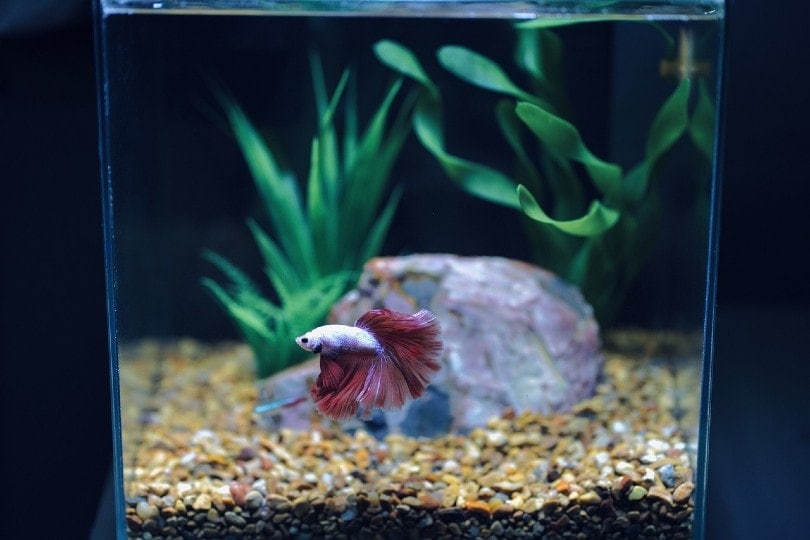
All of the advice above should help you avoid major problems and have a successful spawn but you can do even more to maximize the number of fry who grow into beautiful fish by following these expert tips:
Keep a Feeding Chart
Knowing not only when you feed your fish and fry, but also how much of the food they actually eat makes it easy to know how much food you need to add to the tank each time.
This prevents food from rotting at the bottom of the tank which can lead to health issues in young fry.
Create a Surface Skimmer
To get rid of scum and floating waste drifting at the top of your tank you can create a net using filter cloth from the local pet store and a coat hanger.
You may want some wire to help give the surface skimmer a sturdy shape.
Swipe this through once every couple of days, being careful to avoid scooping up the fry.
Put New Water Through a Filter
Yes, the filter that’s already in your tank will eventually clean out the water, but it’s going to take a while.
The dust in the meantime won’t really harm the fry or fish but it can make it difficult to observe them properly, so get a cartridge filter you can attach to the side of the tank and pour new water in through the filter.
Wipe The Net Before Use
Nets may pick up debris as you move Bettas, so you want to rinse it (with dechlorinated water) before you reuse it.
Have a Full Set of Medication on Hand
Immediate treatment is essential if you want to save as many fry or fish as possible.
Create a betta medicine kit with the help of your aquatic veterinarian. Please note that many commercial chemical medicines aren’t safe for fish fry and are intended for use on adult fish only.
Color Code Power Cords
Eventually, you’re going to have a lot of tank heaters and filters which require many different cords to power, and this is even if you don’t decide to add air stones or other fun things to any of the tanks.
Spray painting the cords different colors makes it easy to sort them.
Get Two Sets of Jars
You should be cleaning your fish jars once a week and it’s much easier if you can have the fish alternate between two jars.
This gives you several days to wash each set and reduces the amount of time the bettas spend in your hand, decreasing the risk of trauma.
Make Fry More Visible
If the wall behind your fry tank is light, you’re going to have a hard time seeing your fry. You can make them more visible by taping black construction paper on the wall directly behind the tank.
Take a Picture to Count Fry
Fry are tiny and translucent, making them almost impossible to count accurately with your naked eye. Even a moderately good phone camera can zoom in far enough to take a picture you can more easily count with.
Final Thoughts
Breeding betta fish is a time consuming and complicated process but if you’re willing to invest in the right equipment and learn everything you can about these beautiful fish before getting started it has the potential to quickly become one of your most fulfilling hobbies. Happy fish keeping!
Featured Image Credit: ivabalk, Pixabay






